Research Progress on Texture Regulation of Rare-Earth Magnesium Alloys
Abstract
1. Introduction
2. Effect of Alloying Elements on Texture
2.1. Effect of Element Types on Texture
2.2. Effect of Element Content on Texture
3. Effect of Processing on Texture of Rare-Earth Magnesium Alloys
3.1. Processing Parameter
3.2. Special Deformation Mode
4. Effect of Recrystallization on Texture
5. Conclusions
Author Contributions
Funding
Conflicts of Interest
References
- Li, K.; Chen, W.; Yin, B.; Ji, C.; Bai, S.; Liao, R.; Yang, T.; Wen, P.; Jiang, B.; Pan, F. A comparative study on WE43 magnesium alloy fabricated by laser powder bed fusion coupled with deep cryogenic treatment: Evolution in microstructure and mechanical properties. Addit. Manuf. 2023, 77, 103814. [Google Scholar] [CrossRef]
- Li, M.; Yang, Q.; Zhao, Z.; Zhang, J.; Li, J. Full liquid phase sintering of binder jetting printed magnesium alloy. J. Manuf. Process. 2023, 108, 194–203. [Google Scholar] [CrossRef]
- Pang, S.; Zhao, W.; Qiu, T.; Liu, W.; Jiao, L.; Wang, X. Study on surface quality and mechanical properties of micro-milling WE43 magnesium alloy cardiovascular stent. J. Manuf. Process. 2023, 101, 1080–1090. [Google Scholar] [CrossRef]
- Weiler, J.P. The role of the Mg17Al12-phase in the high-pressure die-cast magnesium-aluminum alloy system. J. Magnes. Alloys 2023, 11, 4235–4246. [Google Scholar] [CrossRef]
- Li, R.; Liu, Q.; Zhang, R.; Li, Y.; Ma, Y.; Huo, H.; Gao, Y.; Zuo, P.; Wang, J.; Yin, G. Achieving high-energy-density magnesium/sulfur battery via a passivation-free Mg-Li alloy anode. Energy Storage Mater. 2022, 50, 380–386. [Google Scholar] [CrossRef]
- Mei, W.; Li, Q.; Chen, X. Atomic simulation study on the effect of Y atom and grain boundary on tensile deformation in polycrystalline magnesium alloy. J. Mater. Res. Technol. 2023, 23, 931–942. [Google Scholar] [CrossRef]
- Arrabal, R.; Mingo, B.; Pardo, A.; Matykina, E.; Mohedano, M.; Merino, M.C.; Rivas, A.; Maroto, A. Role of alloyed Nd in the microstructure and atmospheric corrosion of as-cast magnesium alloy AZ91. Corros. Sci. 2015, 97, 38–48. [Google Scholar] [CrossRef]
- Wang, R.; Xue, S.; Zhou, W.; Wang, X.; Li, Z.; Meng, Z.; Ma, L. Microstructure evolution and springback behavior in single-pass roll bending of magnesium alloy plates. J. Alloys Compd. 2024, 1009, 176935. [Google Scholar] [CrossRef]
- Du, Y.-z.; Liu, D.-j.; Ge, Y.-f.; Jiang, B.-l. Effects of deformation parameters on microstructure and texture of Mg–Zn–Ce alloy. Trans. Nonferrous Met. Soc. China 2020, 30, 2658–2668. [Google Scholar] [CrossRef]
- Shokri, M.; Zarei-Hanzaki, A.; Abedi, H.R.; Cho, J.H. On the microstructure and RE-texture evolution during hot tensile deformation of Mg-Gd-Y-Zn-Zr alloy. J. Mater. Res. Technol. 2021, 15, 6974–6989. [Google Scholar] [CrossRef]
- Wang, C.; Ning, H.; Liu, S.; You, J.; Wang, T.; Jia, H.-J.; Zha, M.; Wang, H.-Y. Enhanced ductility and strength of Mg-1Zn-1Sn-0.3Y-0.2Ca alloy achieved by novel micro-texture design. Scr. Mater. 2021, 204, 114119. [Google Scholar] [CrossRef]
- Zhao, L.-Q.; Wang, C.; Chen, J.-C.; Ning, H.; Yang, Z.-Z.; Xu, J.; Wang, H.-Y. Development of weak-textured and high-performance Mg–Zn–Ca alloy sheets based on Zn content optimization. J. Alloys Compd. 2020, 849, 156640. [Google Scholar] [CrossRef]
- Malik, A.; Nazeer, F.; Abrar, S.; Cheng, C.; Chen, Z.; Fouda, A.M. Interfacial bonding, texture evolution, and mechanical properties of different structured extruded Mg-7Gd-4Y-1Zn-0.2Zr and Mg-3Zn-1Al-1Ca-0.5Mn composites. J. Magnes. Alloys 2024. [Google Scholar] [CrossRef]
- Wu, Y.P.; Zhang, X.M.; Deng, Y.L.; Tang, C.P.; Zhong, Y.Y. Effect of compression conditions on the microstructure and texture of a Mg–RE alloy. Mater. Sci. Eng. A 2015, 644, 152–158. [Google Scholar] [CrossRef]
- Zhang, G.; Meng, Y.; Yan, F.; Gao, Z.; Yan, Z.; Zhang, Z. Microstructure and texture evolution of Mg-RE-Zn alloy prepared by repetitive upsetting-extrusion under different decreasing temperature degrees. J. Alloys Compd. 2020, 815, 152452. [Google Scholar] [CrossRef]
- Wu, Y.-p.; Xiong, H.-q.; Jia, Y.-z.; Xie, S.-h.; Li, G.-f. Microstructure, texture and mechanical properties of Mg–8Gd–4Y–1Nd–0.5Zr alloy prepared by pre-deformation annealing, hot compression and ageing. Trans. Nonferrous Met. Soc. China 2019, 29, 976–983. [Google Scholar] [CrossRef]
- Zhao, L.; Ma, G.; Jin, P.; Yu, Z. Role of Y on the microstructure, texture and mechanical properties of Mg–Zn–Zr alloys by powder metallurgy. J. Alloys Compd. 2019, 810, 151843. [Google Scholar] [CrossRef]
- Jamili, A.M.; Zarei-Hanzaki, A.; Abedi, H.R.; Minárik, P. The grain boundary character distribution in thermomechanically processed rare earth bearing magnesium alloy. J. Alloys Compd. 2019, 798, 158–166. [Google Scholar] [CrossRef]
- Deng, J.-F.; Tian, J.; Zhou, Y.; Chang, Y.; Liang, W.; Ma, J. Plastic deformation mechanism and hardening mechanism of rolled Rare-Earth magnesium alloy thin sheet. Mater. Des. 2022, 218, 110678. [Google Scholar] [CrossRef]
- Li, T.; Rao, J.; Zheng, J.; Yin, D.; Shou, H.; Zhang, Y.; Shi, R.; Jing, W.; Xia, L. Anisotropic cyclic deformation behavior of an extruded Mg-3Y alloy sheet with rare earth texture. J. Magnes. Alloys 2022, 10, 1581–1597. [Google Scholar] [CrossRef]
- Akyuz, B. Influence of Al content on machinability of AZ series Mg alloys. Trans. Nonferrous Met. Soc. China 2013, 23, 2243–2249. [Google Scholar] [CrossRef]
- Liu, F.-J.; Ji, Y.; Bai, Y.-X. Influence of multipass high rotating speed friction stir processing on microstructure evolution, corrosion behavior and mechanical properties of stirred zone on AZ31 alloy. Trans. Nonferrous Met. Soc. China 2020, 30, 3263–3273. [Google Scholar] [CrossRef]
- Gronostajski, Z.; Kaczyński, P.; Polak, S.; Bartczak, B. Energy absorption of thin-walled profiles made of AZ31 magnesium alloy. Thin-Walled Struct. 2018, 122, 491–500. [Google Scholar] [CrossRef]
- Basu, I.; Al-Samman, T. Triggering rare earth texture modification in magnesium alloys by addition of zinc and zirconium. Acta Mater. 2014, 67, 116–133. [Google Scholar] [CrossRef]
- Zhou, M.; Xu, Y.; Liu, Y.; Duan, M.; Xia, Z.; Huang, L.; Zhu, R.; Ye, H.; Peng, L.; Wu, Y.; et al. Microstructures and mechanical properties of Mg-15Gd-1Zn-0.4Zr alloys treated by ultrasonic surface rolling process. Mater. Sci. Eng. A 2021, 828, 141881. [Google Scholar] [CrossRef]
- Han, F.; Luo, X.; Liu, Q.; Hou, Z.; Marthinsen, K.; Wu, G.L.; Hatzoglou, C.; Kontis, P.; Huang, X. The effect of grain size and rolling reduction on microstructure evolution and annealing hardening response of a Mg-3Gd alloy. J. Magnes. Alloys 2023. [Google Scholar] [CrossRef]
- Zheng, C.; Chen, S.F.; Cheng, M.; Zhan, S.; Li, Y.; Yang, Y.S. Controlling dynamic recrystallization via modified LPSO phase morphology and distribution in Mg-Gd-Y-Zn-Zr alloy. J. Magnes. Alloys. 2023, 11, 4218–4234. [Google Scholar] [CrossRef]
- Prasad, A.; Lee, S.Y.; Singh, S.S.; Gosvami, N.N.; Jain, J. Texture weakening and enhanced recrystallization kinetics in a La containing Mg–Dy alloy. Mater. Chem. Phys. 2022, 277, 125537. [Google Scholar] [CrossRef]
- Molodov, K.D.; Al-Samman, T.; Molodov, D.A. Effect of gadolinium on the deformation and recrystallization behavior of magnesium crystals. Acta Mater. 2022, 240, 118312. [Google Scholar] [CrossRef]
- Abbasi, M.; Bagheri, B.; Sharifi, F. Simulation and experimental study of dynamic recrystallization process during friction stir vibration welding of magnesium alloys. Trans. Nonferrous Met. Soc. China 2021, 31, 2626–2650. [Google Scholar] [CrossRef]
- Tan, M.; Wang, J.; Wu, Y.; Jin, C.; Sun, Y.; Song, L.; Zhang, Y.; Wang, J.; Huo, J.; Gao, M. Accelerated crystallization kinetics and grain refinement in Mg-Ni-Y metallic glass via multiple rare earth elements doping. J. Alloys Compd. 2024, 999, 175080. [Google Scholar] [CrossRef]
- Wei, Q.; Yuan, L.; Ma, X.; Zheng, M.; Shan, D.; Guo, B. Strengthening of low-cost rare earth magnesium alloy Mg-7Gd-2Y–1Zn-0.5Zr through multi-directional forging. Mater. Sci. Eng. A 2022, 831, 142144. [Google Scholar] [CrossRef]
- Kan, Z.; Yang, G.; Xiao, L.; Wang, C.; Qin, H.; Wang, B.; Jie, W. Asymmetric tension-compression mechanical behaviors of extruded Mg-4.58Zn-2.6Gd-0.18Zr alloy with double-peak fiber texture. J. Alloys Compd. 2024, 989, 174291. [Google Scholar] [CrossRef]
- Yang, M.; Jia, H.-L.; Jiang, R.; Zhou, X.-L.; Ma, P.-K.; Li, Z.-G.; Zha, M.; Wang, H.-Y. Excellent synergy of formability and strength of a Mg-Zn-Y-Ca-Zr alloy by tailoring segregation-assisted weak elliptical ring texture. J. Magnes. Alloys 2024. [Google Scholar] [CrossRef]
- Li, J.R.; Xie, D.S.; Zeng, Z.R.; Song, B.; Xie, H.B.; Pei, R.S.; Pan, H.C.; Ren, Y.P.; Qin, G.W. Mechanistic investigation on Ce addition in tuning recrystallization behavior and mechanical property of Mg alloy. J. Mater. Sci. Technol. 2023, 132, 1–17. [Google Scholar] [CrossRef]
- Li, M.; Wang, X.; Xiao, Z.; Liu, Y.; Huang, Y. Effect of dynamic recrystallization, LPSO phase, and grain boundary segregation on heterogeneous bimodal microstructure in Mg-9.8Gd-3.5Y-2.0Zn-0.4Zr alloy. J. Mater. Res. Technol. 2023, 26, 3863–3880. [Google Scholar] [CrossRef]
- Zhang, D.; Liu, C.; Jiang, S.; Gao, Y.; Wan, Y.; Chen, Z. Effects of dynamic recrystallization mechanisms on texture evolution in Mg-Gd-Y-Zr-Ag alloy during hot compression. J. Alloys Compd. 2023, 944, 169190. [Google Scholar] [CrossRef]
- Zhang, N.; Liu, M.; Li, Q.; Chen, X.; Zheng, Z. Effect of long-period stacking ordered phase on dynamic recrystallization in Mg-Y-Zn-Zr alloy processed by backward extrusion. J. Mater. Res. Technol. 2023, 26, 2384–2393. [Google Scholar] [CrossRef]
- Yan, L.; Zhang, Z.; Xue, Y.; Xu, J.; Dong, B.; Li, X. Effect of rotating shear extrusion on the microstructure, texture evolution and mechanical properties of Mg-Gd-Y-Zn-Zr alloy. J. Alloys Compd. 2022, 906, 164406. [Google Scholar] [CrossRef]
- Zheng, Y.-q.; Zhang, Y.; Tian, Y.-q.; Chen, L.-s. Microstructure characteristics and degradation behaviors of medical rare-earth Mg-10.6Gd-0.3Ag-x(Y/Zn) alloys in vitro. J. Alloys Compd. 2024, 997, 174967. [Google Scholar] [CrossRef]
- Zheng, Z.; Dong, Z.; Jiang, B.; Cheng, Y.; Zhang, A.; Song, J.; Li, T.; Pan, F. Evolution of strength with rare-earth content in highly-alloyed Mg-Gd-Y alloys. Scr. Mater. 2024, 238, 115772. [Google Scholar] [CrossRef]
- Zhao, J.; Jiang, B.; Xu, J.; He, W.; Huang, G.; Pan, F. The influence of Gd on the recrystallisation, texture and mechanical properties of Mg alloy. Mater. Sci. Eng. A 2022, 839, 142867. [Google Scholar] [CrossRef]
- Deng, Y.; Yan, H.; Li, Q.; Chen, J.; Xia, W.; Su, B.; Wu, M.; Yu, Y.; Song, M. Enhancing strength and ductility of low RE content Mg-Gd-Y-Zr alloy via a novel thermomechanical treatment based on multi-directional forging. J. Alloys Compd. 2023, 958, 170535. [Google Scholar] [CrossRef]
- Fei, H.-j.; Xu, G.-l.; Liu, L.-b.; Bo, H.; Zeng, L.-j.; Chen, C.-p. Phase equilibria in Mg-rich corner of Mg–Ca–RE (RE=Gd, Nd) systems at 400 °C. Trans. Nonferrous Met. Soc. China 2013, 23, 881–888. [Google Scholar] [CrossRef]
- Luo, K.; Zhang, L.; Wu, G.; Liu, W.; Ding, W. Effect of Y and Gd content on the microstructure and mechanical properties of Mg–Y–RE alloys. J. Magnes. Alloys 2019, 7, 345–354. [Google Scholar] [CrossRef]
- Luo, X.; Yang, H.; Zhou, J.; Jiang, B.; Feng, Q.; Zeng, Y.; Li, W.; Dong, Z.; Song, J.; Xu, J.; et al. Achieving outstanding heat-resistant Mg-Gd-Y-Zn-Mn alloy via introducing RE/Zn segregation on α-Mn nanoparticles. Scr. Mater. 2023, 236, 115672. [Google Scholar] [CrossRef]
- He, Y.; Guo, R.; Zhao, X.; Zhang, Z. High strength and high ductility Mg-Gd-Y-Zn-Zr alloys obtained by controlling texture and dynamic precipitation through LPSO phase structure of different initial morphologies. J. Rare Earths 2024, 42, 2217–2230. [Google Scholar] [CrossRef]
- Meng, D.; Xu, Y.; Jia, J.; Luo, J.; Xu, B. Inhomogeneous deformation behavior and recrystallization mechanism of Mg-Gd-Y-Zn-Zr alloy containing only intragranular lamellar LPSO phase. J. Alloys Compd. 2024, 1003, 175713. [Google Scholar] [CrossRef]
- Chen, W.Q.; Deng, S.; Zhao, X.J.; Luo, S.N. Active {111} and {102} extension twinning in a WE43 Mg alloy. J. Mater. Sci. Technol. 2023, 144, 93–101. [Google Scholar] [CrossRef]
- Yu, Z.; Xu, X.; Shi, K.; Du, B.; Han, X.; Xiao, T.; Li, S.; Liu, K.; Du, W. Development and characteristics of a low rare-earth containing magnesium alloy with high strength-ductility synergy. J. Magnes. Alloys 2023, 11, 1629–1642. [Google Scholar] [CrossRef]
- Xiang, C.; Xu, Y.; Yang, Y.; Ding, H.; Wang, Z. Plastic deformation mechanisms and constitutive modeling of WE43 magnesium alloy at various strain rates and temperatures. J. Mater. Res. Technol. 2024, 29, 4110–4128. [Google Scholar] [CrossRef]
- Salandari-Rabori, A.; Zarei-Hanzaki, A.; Abedi, H.R.; Lecomte, J.S.; Khatami-Hamedani, H. Micro and macro texture evolution during multiaxial forging of a WE43 magnesium alloy. J. Alloys Compd. 2018, 739, 249–259. [Google Scholar] [CrossRef]
- Jiang, H.S.; Zheng, M.Y.; Qiao, X.G.; Wu, K.; Peng, Q.Y.; Yang, S.H.; Yuan, Y.H.; Luo, J.H. Microstructure and mechanical properties of WE43 magnesium alloy fabricated by direct-chill casting. Mater. Sci. Eng. A 2017, 684, 158–164. [Google Scholar] [CrossRef]
- Liu, J.B.; Zhang, K.; Han, J.T.; Li, X.G.; Li, Y.J.; Ma, M.L.; Yuan, J.W.; Shi, G.L.; Li, M.; Lu, C.F. Study on the microstructure and mechanical Properties of WE71 magnesium alloy. Mater. Sci. Eng. A 2015, 625, 107–113. [Google Scholar] [CrossRef]
- Gao, S.; Wei, X.; Le, Q.; Ren, L.; Hu, J.; Wu, J.; Wang, T.; Liao, Q.; Bao, L. Magnesium alloys strengthened with a combination of light rare earth element Ce and heavy rare earth element Y. Mater. Today Commun. 2025, 43, 111682. [Google Scholar] [CrossRef]
- Woo, S.K.; Pei, R.; Al-Samman, T.; Letzig, D.; Yi, S. Plastic instability and texture modification in extruded Mg-Mn-Nd alloy. J. Magnes. Alloys 2022, 10, 146–159. [Google Scholar] [CrossRef]
- Zhang, Z.; Kim, J.; Pu, H.; Zhou, S.; Hu, Y.; Huang, G.; Jiang, B.; Pan, F. Improving mechanical properties of Mg–Zn-Nd-Zr alloy by low alloying with Yb and corresponding strengthening mechanisms. J. Mater. Res. Technol. 2024, 33, 2023–2034. [Google Scholar] [CrossRef]
- Li, L.; Zhang, C.; Lv, H.; Liu, C.; Wen, Z.; Jiang, J. Texture development and tensile properties of Mg–Yb binary alloys during hot extrusion and subsequent annealing. J. Magnes. Alloys 2022, 10, 249–265. [Google Scholar] [CrossRef]
- Zhou, B.; Wang, X.; Jiang, J.; Chen, C.; Zhang, X.; Niu, J.; Pei, J.; Huang, H.; Wang, D.; Yuan, G. Superior strength-ductility synergy of Mg-Nd-Zn-Zr alloy rod achieved by drawing at elevated temperatures. Int. J. Plast. 2024, 175, 103944. [Google Scholar] [CrossRef]
- Zhang, S.; Fan, Y.; Zhao, H.; Dong, X.; Guo, C.; Zhang, S.; Weng, K.; Xiao, Y. A comparative study on the effect of 0.5 wt% Ca or Ce on the microstructure, texture, and mechanical properties of the hot-rolled Mg-4Li alloy. Mater. Today Commun. 2024, 39, 108540. [Google Scholar] [CrossRef]
- Li, L.; Wang, Y.; Zhang, C.; Wang, T.; Lv, H.; Yu, W. Ultrafine-grained Mg–Zn–Yb–Zr alloy with simultaneously improved strength and ductility processed by axisymmetric hot extrusion. Vacuum 2020, 173, 109157. [Google Scholar] [CrossRef]
- Xie, H.; Wang, J.; Li, Y.; Song, J.; Hu, H.; Qin, L.; Zhao, H.; Li, C.; Cui, Y.; Tan, Z.; et al. Fast shot speed induced microstructure and mechanical property evolution of high pressure die casting Mg-Al-Zn-RE alloys. J. Mater. Process. Technol. 2024, 331, 118523. [Google Scholar] [CrossRef]
- Mouhib, F.; Pei, R.; Erol, B.; Sheng, F.; Korte-Kerzel, S.; Al-Samman, T. Synergistic effects of solutes on active deformation modes, grain boundary segregation and texture evolution in Mg-Gd-Zn alloys. Mater. Sci. Eng. A 2022, 847, 143348. [Google Scholar] [CrossRef]
- Al-Samman, T.; Li, X. Sheet texture modification in magnesium-based alloys by selective rare earth alloying. Mater. Sci. Eng. A 2011, 528, 3809–3822. [Google Scholar] [CrossRef]
- Jun, Z.; Bin, J.; Yuan, Y.; Wang, Q.; Yuan, M.; Tang, A.; Huang, G.; Zhang, D.; Fusheng, P. Understanding the enhanced ductility of Mg-Gd with Ca and Zn microalloying by slip trace analysis. J. Mater. Sci. Technol. 2021, 95, 20–28. [Google Scholar] [CrossRef]
- Wang, L.; Hu, S.; Xi, C.; Zhou, W.; Sakai, T.; Yang, X.; Huo, Q. Tensile creep anisotropy and its weakening mechanism in a dilute Mg-Ca alloy. J. Magnes. Alloys 2024. [Google Scholar] [CrossRef]
- Li, Z.H.; Cheng, D.; Wang, K.; Hoglund, E.R.; Howe, J.M.; Zhou, B.C.; Sasaki, T.T.; Ohkubo, T.; Hono, K. Revisited precipitation process in dilute Mg-Ca-Zn alloys. Acta Mater. 2023, 257, 119072. [Google Scholar] [CrossRef]
- Li, Z.; Liu, F.; Yuan, A.; Duan, B.; Li, Y.; Li, X. Effect of rolling deformation on microstructure and texture of spray-deposited magnesium alloy containing Mg-Nd-Zn typed LPSO. J. Mater. Sci. Technol. 2017, 33, 630–636. [Google Scholar] [CrossRef]
- He, Z.; Zhang, Y.; Liang, J.; Li, Y. Quantitative investigation on the individual contribution of twinning and dislocation slip to creep in dilute Mg-Y alloys with various grain sizes. J. Alloys Compd. 2024, 990, 174473. [Google Scholar] [CrossRef]
- Sarebanzadeh, M.; Orozco-Caballero, A.; Llorca, J. Accurate determination of active slip systems for improved geometrical criteria of basal-to-basal slip transfer at grain boundaries in pure Mg. Acta Mater. 2023, 243, 118536. [Google Scholar] [CrossRef]
- Wang, S.; Niu, E.; Zhang, Q.; Ouyang, S.; Shen, X.; She, J.; Tang, A.; Chen, X.; Pan, F. Advancing biodegradable Mg-Gd-Y alloy for cardiovascular stent applications. Mater. Today Commun. 2024, 41, 110893. [Google Scholar] [CrossRef]
- Kim, S.-H.; Jung, J.-G.; You, B.S.; Park, S.H. Microstructure and texture variation with Gd addition in extruded magnesium. J. Alloys Compd. 2017, 695, 344–350. [Google Scholar] [CrossRef]
- Wang, X.; Zhao, Y.; Li, M.; Tang, S.; Huang, Y.; Liu, Y.; Huang, C. Achieving enhanced mechanical properties of extruded Mg-Gd-Y-Zn-Zr alloy by regulating the initial LPSO phases. Mater. Sci. Eng. A 2024, 917, 147411. [Google Scholar] [CrossRef]
- Wang, Y.; Rong, W.; Wu, Y.J.; Peng, L.M.; Chen, J.; Ding, W.J. Effects of Mn addition on the microstructures and mechanical properties of the Mg-15Gd-1Zn alloy. J. Alloys Compd. 2017, 698, 1066–1076. [Google Scholar] [CrossRef]
- Chen, M.; Tao, X.; Wang, L.; Ma, K.; Zhang, D.; Li, Y.; Wei, S.; Zhang, Z.; Zhao, Z.; Bai, P. Phase transformation during solid-solution and aging treatment of a Mg-Gd-Y-Zn-Zr alloy containing LPSO and W phases. J. Alloys Compd. 2024, 1005, 176176. [Google Scholar] [CrossRef]
- Yang, W.; Quan, G.F.; Ji, B.; Wan, Y.F.; Zhou, H.; Zheng, J.; Yin, D.D. Effect of Y content and equal channel angular pressing on the microstructure, texture and mechanical property of extruded Mg-Y alloys. J. Magnes. Alloys 2022, 10, 195–208. [Google Scholar] [CrossRef]
- Zhao, J.; Jiang, B.; Wang, Q.; Yang, H.; Yuan, M.; Huang, G.; Zhang, D.; Pan, F. Influence of Ce content on the microstructures and tensile properties of Mg-1Gd-0.5Zn alloys. Mater. Sci. Eng. A 2021, 823, 141675. [Google Scholar] [CrossRef]
- Ci, W.; Deng, L.; Chen, X.; Liu, C.; Pan, F. Effect of minor Ca addition on microstructure and corrosion behavior of Mg–Y–Ca alloys. J. Mater. Res. Technol. 2023, 26, 7502–7515. [Google Scholar] [CrossRef]
- Liao, H.; Kim, J.; Lv, J.; Jiang, B.; Chen, X.; Pan, F. Microstructure and mechanical properties with various pre-treatment and Zn content in Mg-Gd-Y-Zn alloys. J. Alloys Compd. 2020, 831, 154873. [Google Scholar] [CrossRef]
- Hantzsche, K.; Bohlen, J.; Wendt, J.; Kainer, K.U.; Yi, S.B.; Letzig, D. Effect of rare earth additions on microstructure and texture development of magnesium alloy sheets. Scr. Mater. 2010, 63, 725–730. [Google Scholar] [CrossRef]
- Peng, J.; Zhang, Z.; Li, Y.; Zhou, W.; Wu, Y. Twinning-induced dynamic recrystallization and micro-plastic mechanism during hot-rolling process of a magnesium alloy. Mater. Sci. Eng. A 2017, 699, 99–105. [Google Scholar] [CrossRef]
- Zhang, L.; Li, Y. Dynamic recrystallization mechanism, texture evolution development and mechanical characteristics of a Mg–8.7Gd–4.18Y–0.42Zr magnesium alloy by ECAP. Prog. Nat. Sci. Mater. Int. 2024, 34, 376–388. [Google Scholar] [CrossRef]
- Zhao, T.; Dai, Y.; Zheng, T.; Hu, Y.; Jiang, B.; Pan, F. The extrusion ratios modification of Mg-2Gd-xMn alloys to exploration of the strengthening mechanisms. J. Mater. Res. Technol. 2024, 30, 2147–2157. [Google Scholar] [CrossRef]
- Pei, Y.; Yuan, M.; Wei, E.; Zhang, Z.; Zhao, M.; Ma, H.; Teng, B. Cooperative achievement in grain refinement and texture weakening of Mg-Gd-Y-Sm-Zr alloy fabricated by asymmetric extrusion-shear process. Mater. Sci. Eng. A 2024, 895, 146262. [Google Scholar] [CrossRef]
- Liu, W.; Zhang, C.; Guo, P.; Shi, Q.; Feng, H.; Zhang, S.; Han, F. Achieving enhanced mechanical properties in the Mg–Y–Zn–V alloy by refining grains and improving the morphology and distribution of LPSO via pre-forging and subsequent rolling. J. Mater. Res. Technol. 2024, 29, 2493–2504. [Google Scholar] [CrossRef]
- Li, Q.-k.; Yan, H.; Chen, R.-s. Effect of rolling reduction on deformation mechanism and twinning behavior of WE43 magnesium alloy. Trans. Nonferrous Met. Soc. China 2022, 32, 3901–3913. [Google Scholar] [CrossRef]
- Liang, S.; Ren, Q.; Li, X.; Luan, S.; Li, X.; Jin, P.; Wang, J. The dynamic recrystallization induced by Al2Nd and promoted by Al2RE in a hot compressed Mg–1Al-1.5Nd-1.5Y-0.5Gd alloy. J. Mater. Res. Technol. 2024, 33, 8232–8245. [Google Scholar] [CrossRef]
- Nienaber, M.; Bohlen, J.; Yi, S.; Kurz, G.; Kainer, K.U.; Letzig, D. Influence of Ca addition on the dynamic and static recrystallization behavior of direct extruded flat profiles of Mg-Y-Zn alloy. J. Magnes. Alloys 2023, 11, 3736–3748. [Google Scholar] [CrossRef]
- Wang, X.; Gao, M.; Miao, L.; Tan, L.; Yang, K. Study of rotational dynamic recrystallization during warm compression of an Mg-Zn-Nd-Zr alloy. Mater. Today Commun. 2024, 38, 107928. [Google Scholar] [CrossRef]
- Ling, Z.; Yang, K.; Wang, L.; Ma, K.; Zhang, D.; Li, Y.; Zhang, Z.; Zhao, Z.; Bai, P. Hot deformation behavior and microstructural evolutions of a Mg-Gd-Y-Zn-Zr alloy prepared by hot extrusion. J. Alloys Compd. 2024, 1009, 176916. [Google Scholar] [CrossRef]
- Chen, T.; Chen, Z.; Shao, J.; Wang, R.; Mao, L.; Liu, C. The role of long period stacking ordered phase in dynamic recrystallization of a Mg–Zn–Y alloy during hot compression. J. Alloys Compd. 2020, 818, 152814. [Google Scholar] [CrossRef]
- Hao, J.; Zhao, L.; Zhang, J.; Wang, H.; Cheng, W.; Li, B.; Bai, Y. Study on equal channel angular pressing process of Mg–Zn–Y–Mn–Ti magnesium alloy enhanced by lamellar LPSO phase and spherical W phase. J. Mater. Res. Technol. 2023, 25, 7078–7089. [Google Scholar] [CrossRef]
- Luo, X.; Feng, Z.; Yu, T.; Huang, T.; Li, R.; Wu, G.; Hansen, N.; Huang, X. Microstructural evolution in Mg-3Gd during accumulative roll-bonding. Mater. Sci. Eng. A 2020, 772, 138763. [Google Scholar] [CrossRef]
- Li, X.; Li, X.; Ye, Y.; Zhang, R.; Kure-Chu, S.-Z.; Tang, G. Deformation mechanisms and recrystallization behavior of Mg-3Al-1Zn and Mg-1Gd alloys deformed by electroplastic-asymmetric rolling. Mater. Sci. Eng. A 2019, 742, 722–733. [Google Scholar] [CrossRef]
- Kwak, T.Y.; Lim, H.K.; Han, S.H.; Kim, W.J. Refinement of the icosahedral quasicrystalline phase and the grain size of Mg–9.25Zn–1.66Y alloy by high-ratio differential speed rolling. Scr. Mater. 2015, 103, 49–52. [Google Scholar] [CrossRef]
- Minárik, P.; Zemková, M.; Veselý, J.; Bohlen, J.; Knapek, M.; Král, R. The effect of Zr on dynamic recrystallization during ECAP processing of Mg-Y-RE alloys. Mater. Charact. 2021, 174, 111033. [Google Scholar] [CrossRef]
- Wang, D.; Xu, D.; Wang, B.; Yan, C.; Wang, S.; Xu, X.; Zhang, L.; Lu, C. Effect of cross rolling on the microstructure and mechanical performance of a dual-phase structured Mg-8Li-6Zn-1Y (in wt.%) alloy. J. Mater. Sci. Technol. 2024, 176, 132–144. [Google Scholar] [CrossRef]
- Chen, H.; Han, Y.; Liu, C.; Chen, Z. Effect of unidirectional rolling and cross-rolling on microstructure and mechanical anisotropy of Mg-Gd-Y-Ag-Zr plates. J. Alloys Compd. 2023, 960, 170680. [Google Scholar] [CrossRef]
- An, D.; Qian, B.; Wu, R.; Wang, X.; Hou, L.; Ma, X.; Zhang, J. Influence of power dissipation value and deformation activation energy on recrystallization in compression deformation behavior of Mg-Li-Zn-Y alloy. J. Rare Earths 2024, 42, 2341–2349. [Google Scholar] [CrossRef]
- Guan, D.; Rainforth, W.M.; Gao, J.; Ma, L.; Wynne, B. Individual effect of recrystallisation nucleation sites on texture weakening in a magnesium alloy: Part 2- shear bands. Acta Mater. 2018, 145, 399–412. [Google Scholar] [CrossRef]
- Sagapuram, D.; Viswanathan, K. Evidence for Bingham plastic boundary layers in shear banding of metals. Extrem. Mech. Lett. 2018, 25, 27–36. [Google Scholar] [CrossRef]
- Shi, B.Q.; Wang, Y.Z.; Shang, X.L.; Zhao, L.Y.; Li, C.Q.; Chen, D.C.; Nie, B.H.; Chen, R.S.; Ke, W. Microstructure evolution of twinning-induced shear bands and correlation with ‘RD-split’ texture during hot rolling in a Mg-1.1Zn-0.76Y-0.56Zr alloy. Mater. Charact. 2022, 187, 111853. [Google Scholar] [CrossRef]
- Ding, N.; Du, W.; Li, S.; Liu, K.; Du, X.; Yu, Z. Strain rate dependence of dynamic recrystallization and texture evolution in hot compressed Mg-Gd-Er-Zr alloy. J. Magnes. Alloys 2023, 13, 161–171. [Google Scholar] [CrossRef]
- Han, L.; Yu, Y.; Wei, D.; Wang, X.; Zhao, G.; Wang, G. The synergistic and interactive effects of slip systems and dynamic recrystallization on the weakening basal texture of Mg-Y-Nd-Zr-Gd magnesium alloy. Mater. Des. 2024, 237, 112583. [Google Scholar] [CrossRef]
- Li, Q.; Yan, H.; Liu, H.; Chen, R. Dynamic recrystallization mechanism and near-isotropic mechanical properties of WE43 magnesium alloy sheets rolled at different temperatures. Mater. Charact. 2022, 193, 112259. [Google Scholar] [CrossRef]
- Sabat, R.K.; Samal, P.K.; Ahamed, S.M. Effect of strain path on the evolution of microstructure, texture and tensile properties of WE43 alloy. Mater. Sci. Eng. A 2018, 715, 348–358. [Google Scholar] [CrossRef]
- Pan, F.; Zeng, B.; Jiang, B.; Atrens, A.; Dong, H. Deformation mechanism and microstructure evolution during on-line heating rolling of AZ31B Mg thin sheets. Mater. Charact. 2017, 124, 266–275. [Google Scholar] [CrossRef][Green Version]
- Li, J.; Li, X.; Xu, T.; Yan, H.; Mao, Y.; Chen, R. Regulating the grain refinement and rolling properties of coarse-crystalline Mg-Zn-Gd-Ca-Mn alloy through multi-pass cold rolling and annealing. Mater. Sci. Eng. A 2024, 911, 146940. [Google Scholar] [CrossRef]
- Yan, H.; Xu, S.W.; Chen, R.S.; Kamado, S.; Honma, T.; Han, E.H. Twins, shear bands and recrystallization of a Mg–2.0%Zn–0.8%Gd alloy during rolling. Scr. Mater. 2011, 64, 141–144. [Google Scholar] [CrossRef]
- Wang, J.; Zhu, G.; Wang, L.; Zhu, Q.; Vasilev, E.; Zeng, X.; Knezevic, M. Dislocation-induced plastic instability in a rare earth containing magnesium alloy. Materialia 2021, 15, 101038. [Google Scholar] [CrossRef]
- Wang, X.; Li, M.; Huang, Y.; Liu, Y.; Huang, C. Deformation behavior of LPSO phases with regulated morphology and distribution and their role on dynamic recrystallization in hot-rolled Mg–Gd–Y–Zn–Zr alloy. J. Mater. Res. Technol. 2023, 26, 6121–6134. [Google Scholar] [CrossRef]
- Chen, W.; Ma, J.; Cui, C.; Zhang, W.; Wang, W.; Liu, X.; Yang, J.; Cui, G. Texture role in the mechanical property improvement contributed by grain refinement for Mg-2.6Nd-0.55Zn-0.5Zr alloy subjected to extrusion process. Mater. Sci. Eng. A 2022, 831, 142185. [Google Scholar] [CrossRef]
- Dong, B.; Chai, J.; Wu, G.; Zhang, H.; Zhang, Z.; Yu, J.; Xue, Y.; Meng, M. Dynamic recrystallization behavior and strengthening mechanism of Mg–Gd–Y–Zn–Zr alloy during isothermal MDF process. J. Mater. Res. Technol. 2022, 21, 1419–1433. [Google Scholar] [CrossRef]
- Gao, W.; Dong, X.; Fan, Y.; Zhao, H.; Guo, C.; Weng, K.; Xiao, Y. A comparative study on the microstructure, texture, and mechanical properties of extruded Mg–9Li and Mg–9Li-0.3Ca alloys. Mater. Sci. Eng. A 2022, 854, 143844. [Google Scholar] [CrossRef]
- Zhang, Z.; Kim, J.; Li, M.; Gao, Y.; Hu, Y.; Jiang, B.; Pan, F. Effects of Nd content on the microstructures and mechanical properties of ZK60 Mg alloy and corresponding strengthening mechanisms. Mater. Sci. Eng. A 2024, 901, 146504. [Google Scholar] [CrossRef]
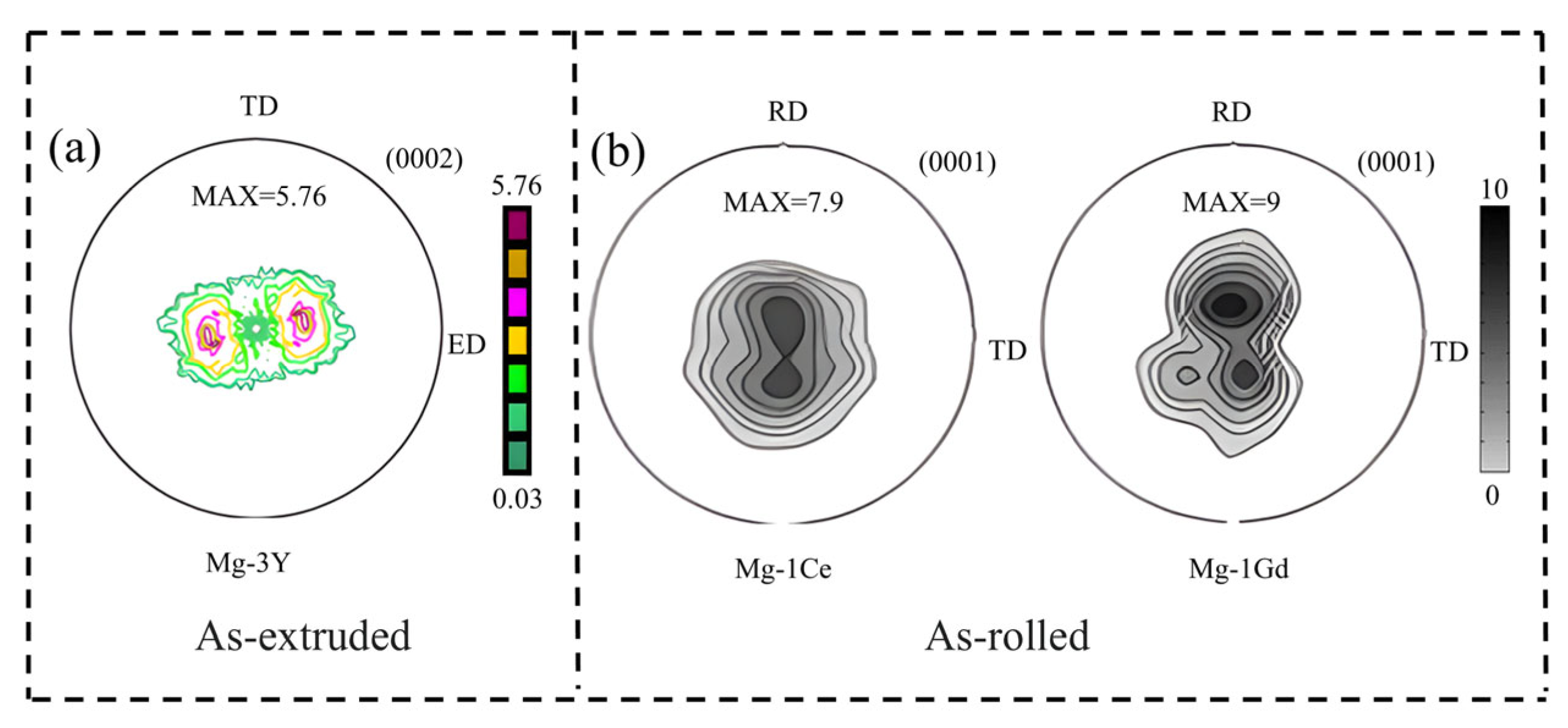
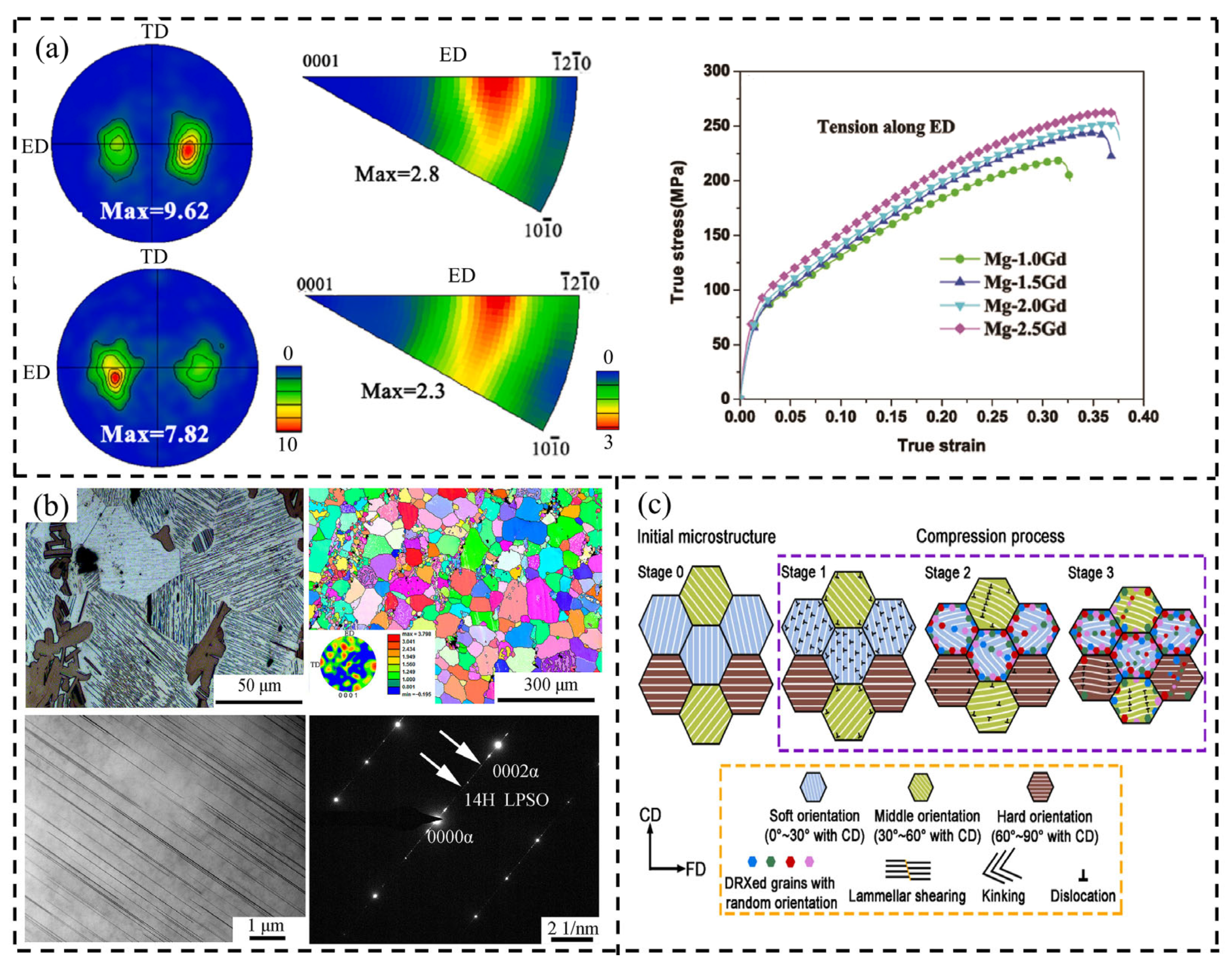
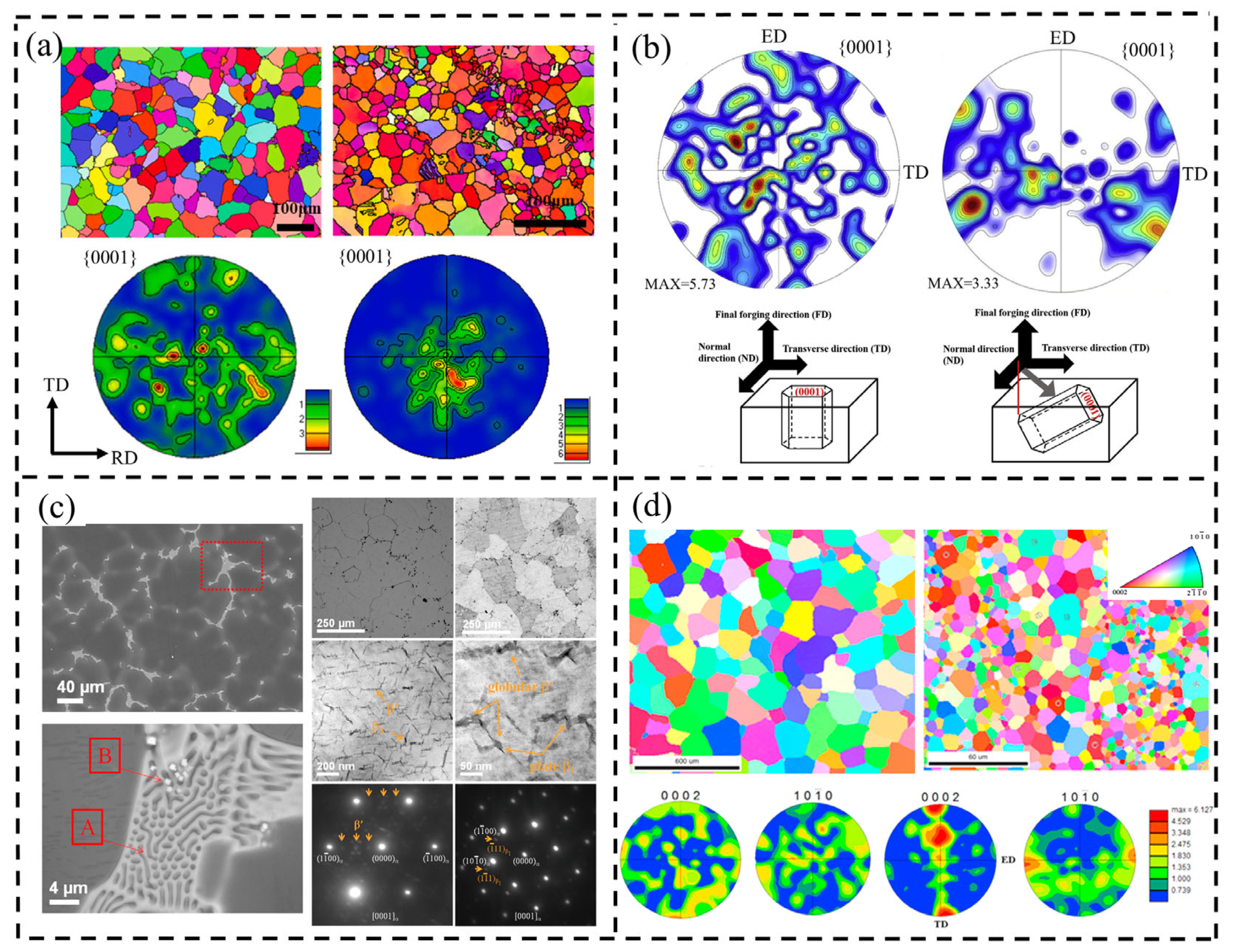


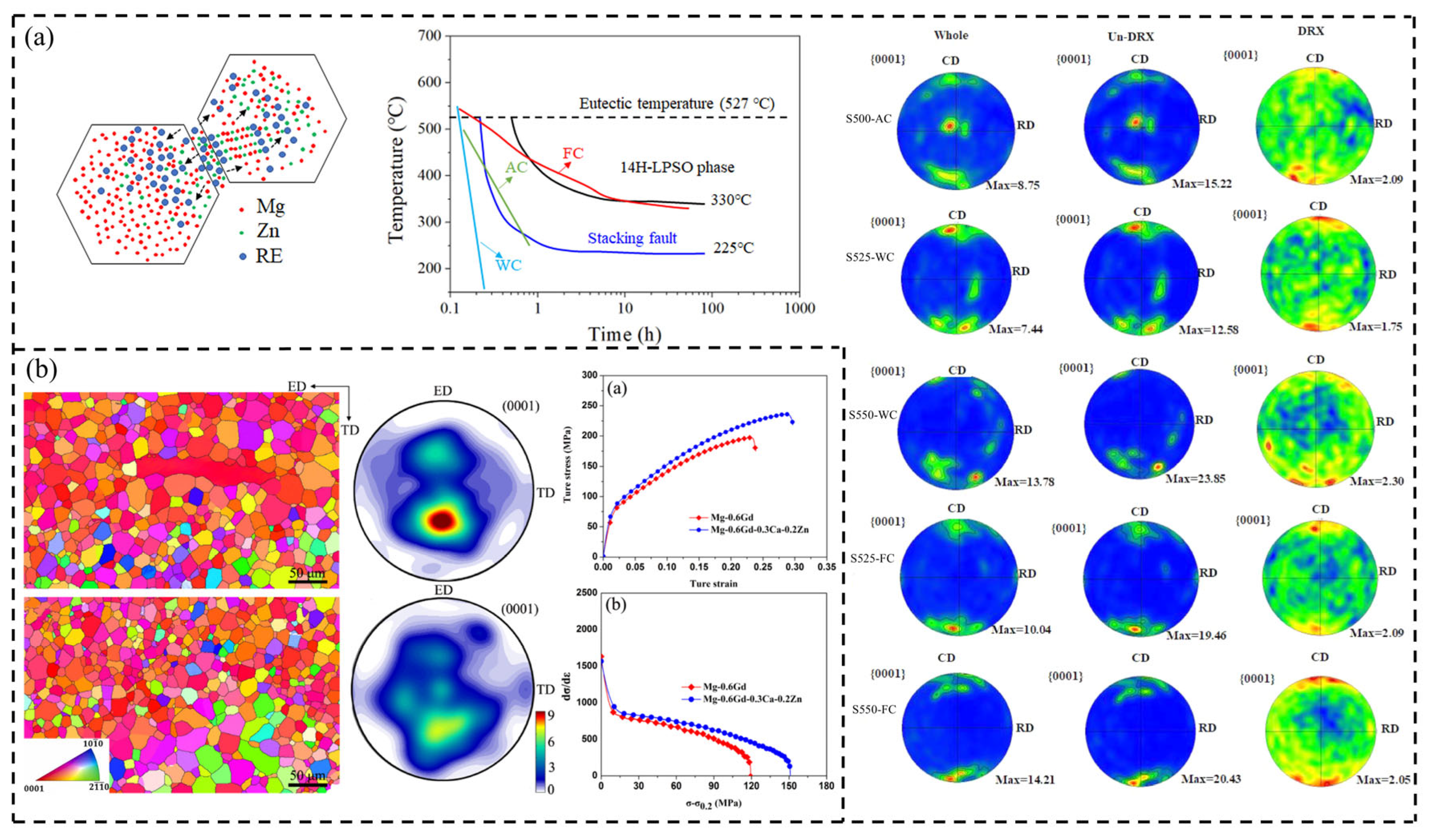

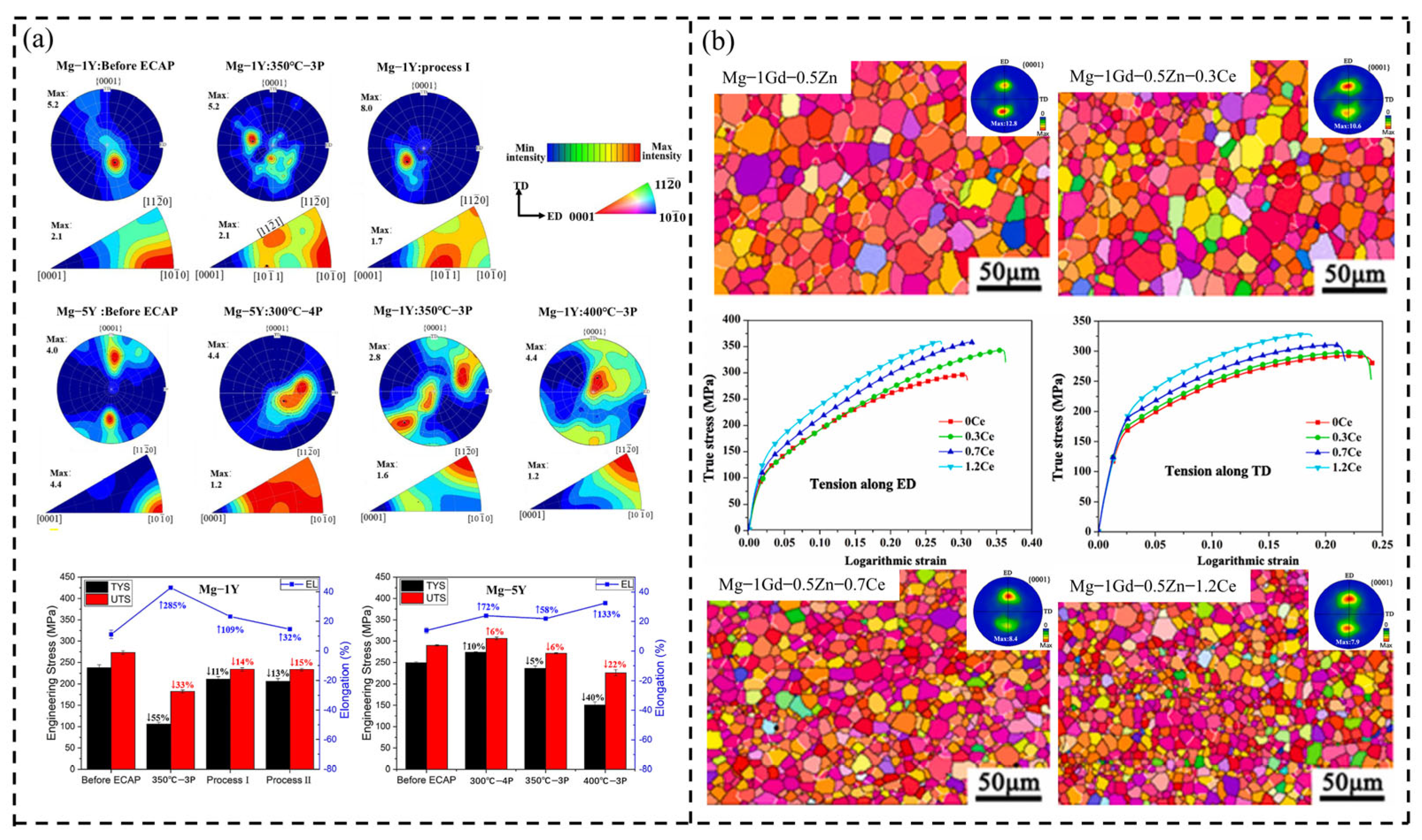





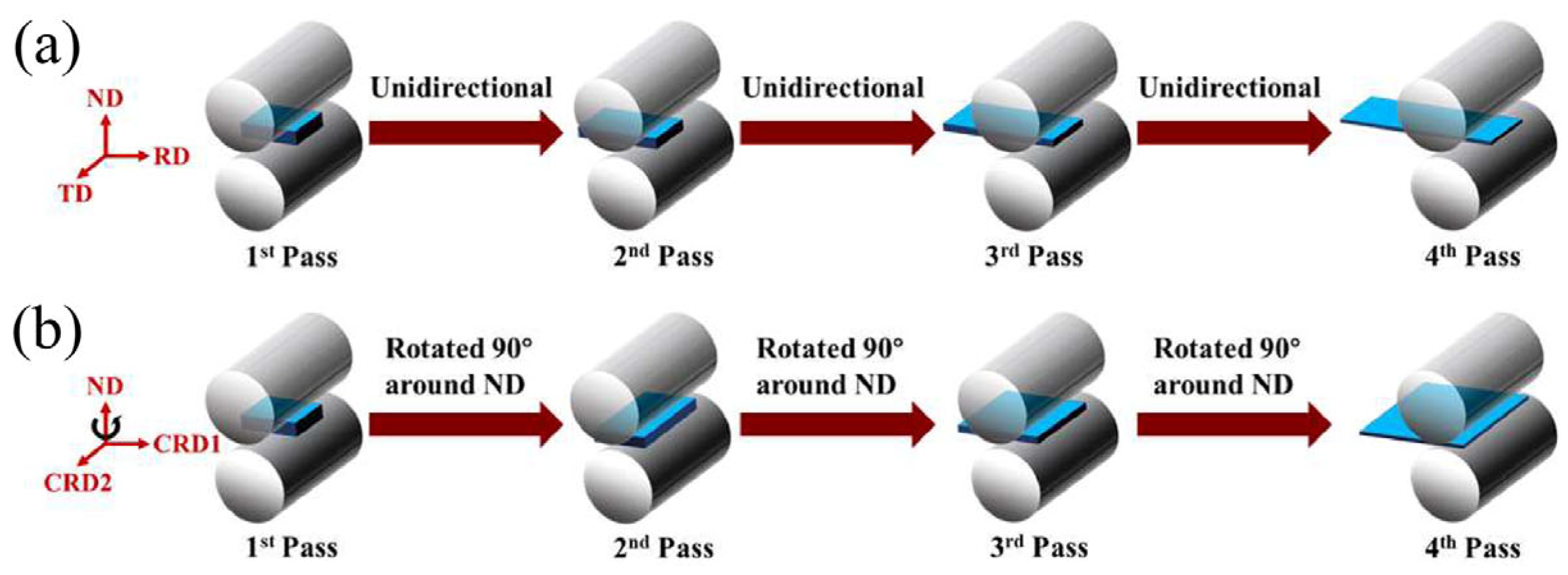

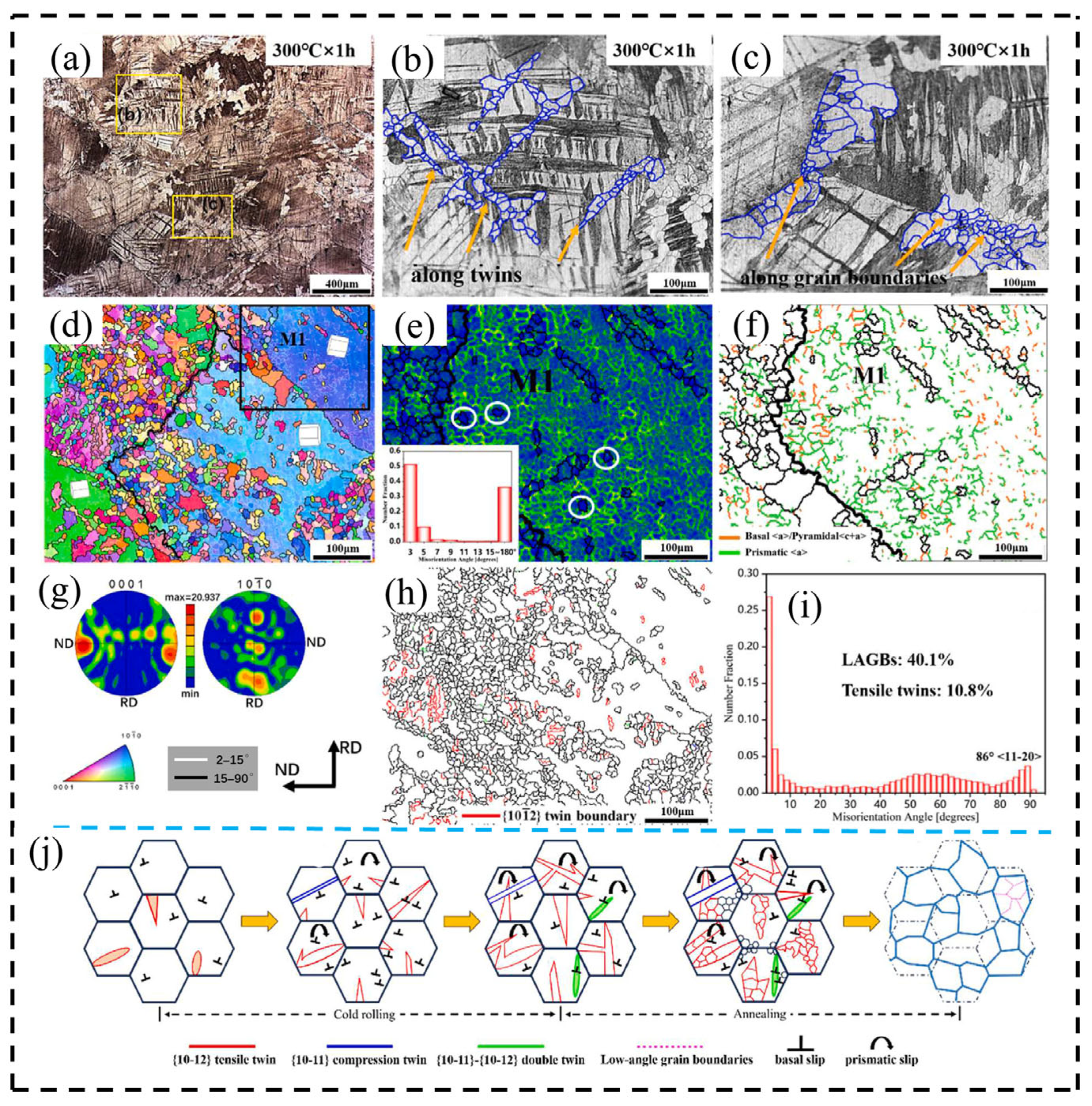
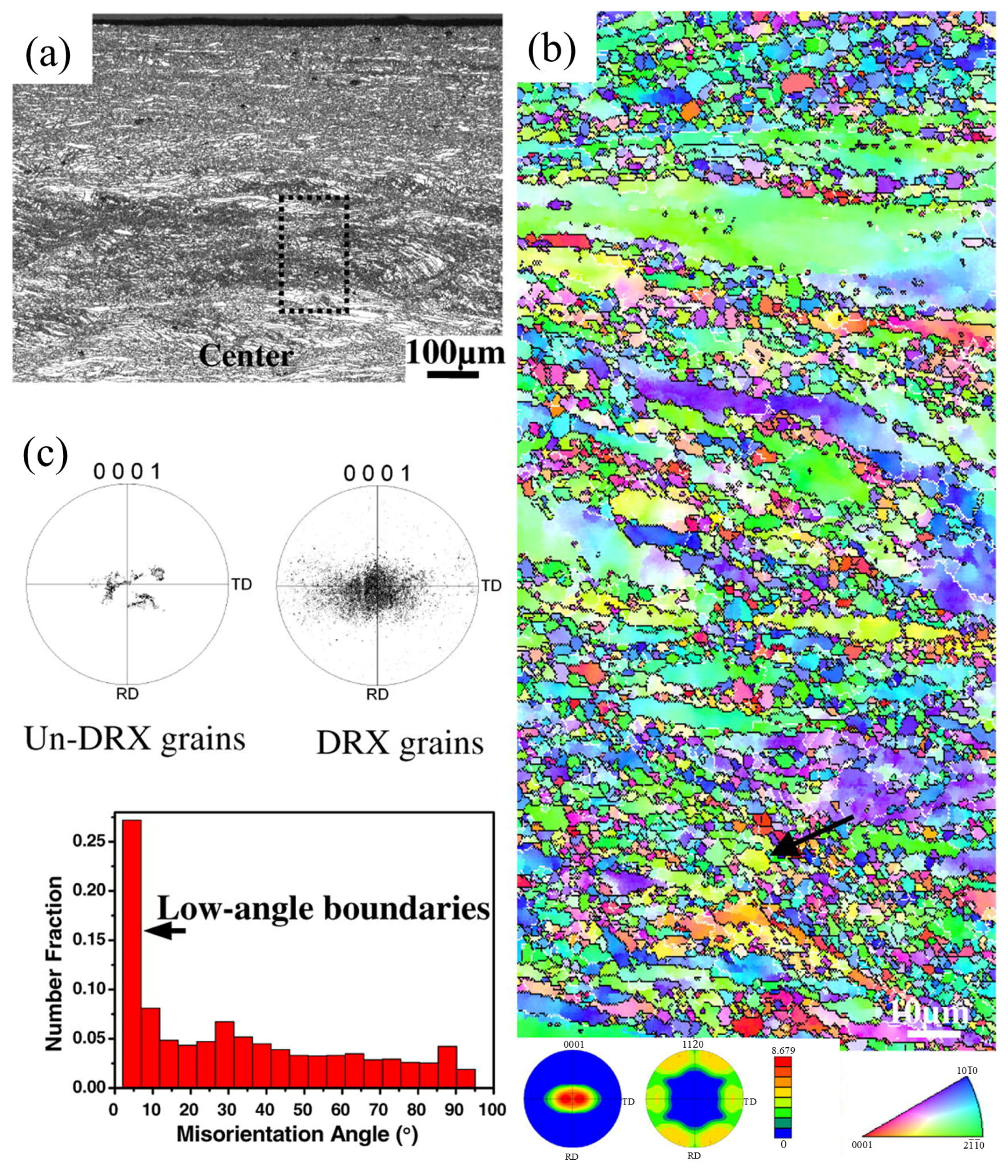
Disclaimer/Publisher’s Note: The statements, opinions and data contained in all publications are solely those of the individual author(s) and contributor(s) and not of MDPI and/or the editor(s). MDPI and/or the editor(s) disclaim responsibility for any injury to people or property resulting from any ideas, methods, instructions or products referred to in the content. |
© 2025 by the authors. Licensee MDPI, Basel, Switzerland. This article is an open access article distributed under the terms and conditions of the Creative Commons Attribution (CC BY) license (https://creativecommons.org/licenses/by/4.0/).
Share and Cite
Liu, W.; Wei, B.; Li, R.; Wang, X.; Wu, H.; Fang, W. Research Progress on Texture Regulation of Rare-Earth Magnesium Alloys. Solids 2025, 6, 11. https://doi.org/10.3390/solids6010011
Liu W, Wei B, Li R, Wang X, Wu H, Fang W. Research Progress on Texture Regulation of Rare-Earth Magnesium Alloys. Solids. 2025; 6(1):11. https://doi.org/10.3390/solids6010011
Chicago/Turabian StyleLiu, Weiyan, Boxin Wei, Rengeng Li, Xin Wang, Hao Wu, and Wenbin Fang. 2025. "Research Progress on Texture Regulation of Rare-Earth Magnesium Alloys" Solids 6, no. 1: 11. https://doi.org/10.3390/solids6010011
APA StyleLiu, W., Wei, B., Li, R., Wang, X., Wu, H., & Fang, W. (2025). Research Progress on Texture Regulation of Rare-Earth Magnesium Alloys. Solids, 6(1), 11. https://doi.org/10.3390/solids6010011







